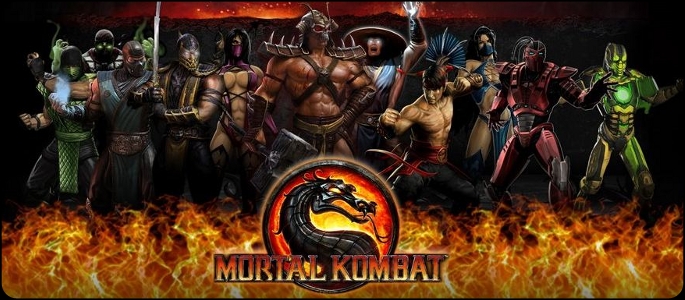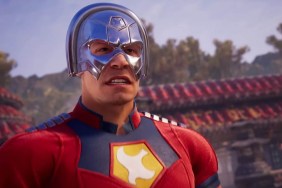In my early impressionable years, I spent a lot of time in local arcades, bowling alleys, even the nearest cinema. Anywhere where there was some arcade machines, you’d find me there with a fist full of quarters. One day, as I arrived at my favorite arcade to spend a few bucks playing Street Fighter II, I discovered that a new arcade cabinet had been installed in its place. Pissed that I was missing out on the fight I had come to know and love, I was reluctant to try this new game. What was this Mortal Kombat? I inserted my coins as the machine demanded and I gave it a shot. I got my ass handed to me by Kano and I didn’t at all mind because of what came next…
Fatality. He ripped my still beating heart from my chest. Shocked and in awe, I stood there stunned. How could I ever go back to simple hadokens and sonic booms ever again? Truth is, I didn’t. I was hooked on Mortal Kombat, and thus began my lifelong love affair.
Mortal Kombat created a wave of controversy, was condemned by politicians and parents, and is mostly responsible for the creation of the Entertainment Software Ratings Board (ESRB). Gore and mutilation of this magnitude hadn’t ever been realized before in mainstream video games. And certainly not on realistic-looking digitized characters. This in part, is why I loved the series. But it wasn’t just to quench my lust for blood. The gameplay was deep: chaining combos took skill and practice, learning fatalities was done solely through trial-and-error or via word of mouth (there wasn’t always the internet, ya know!). If you wanted to be a worthy kombatant in Mortal Kombat, you had to be dedicated.
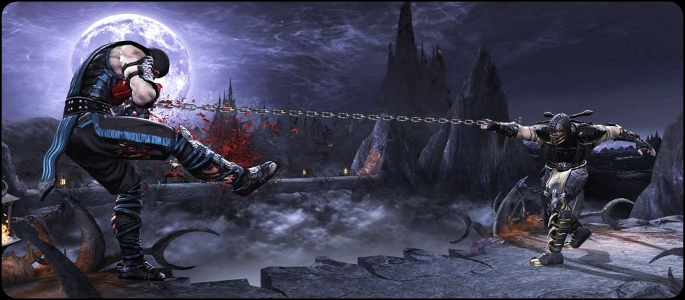
Mortal Kombat II came along, expanded the roster, introduced some new ‘alities and polished the fighting system to near perfection. Mortal Kombat 3 added a run button, some more ‘alities, and button-press combos. Things were progressing along nicely for the still-somewhat-new franchise. Then 3D fighters became all the rage. How could Mortal Kombat, a 2D fighter compete? Mortal Kombat 4 hit arcades as the series first 3D installment, and this is where things started spiraling out of control.
Spin-offs like the Sub-Zero focused action title Mythologies left a bloody stain on the series’ namesake. Things only continued to get worse, at least for “old-school” fans like myself. Deception and Armageddon weren’t what I’d call bad games, but the gameplay and the new characters added never really meshed with what I knew to be “real” Mortal Kombat. I longed for the series to return to its roots. After MK Vs. DC Universe, I thought there was no turning back… until this past Summer, when a new Mortal Kombat was announced. A Mortal Kombat for the long-time fans. A Mortal Kombat that would return to its fatality-filled ways. A Mortal Kombat… for me.
I’m happy to say that Mortal Kombat, in every way, is the series that I fell in love with so many years ago. All of the best characters are back in a re-telling of Mortal Kombats 1-3. As the story goes, Raiden is about to meet certain doom at the massive hands of Shao Kahn, when he sends a vision back to his former self just prior to the first Mortal Kombat tournament, so that he may alter the outcome of the future.
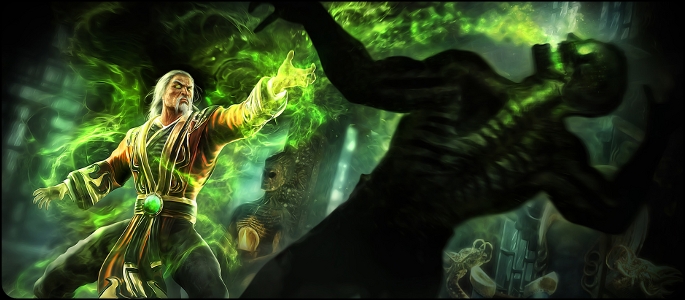
Mortal Kombat is known for characters that are “out-there”, and each backstory behind them is just as wacky, sometimes confusing, even for die-hard fans like myself. However, Mortal Kombat‘s all-new Story mode ties each character’s story together perfectly, explaining the reasons behind some pressing questions. Such as which Sub-Zero is the original Sub-Zero and how the hell did Cyrax and Sektor become cyborgs. Although, since this is a re-telling, some of the story has been altered by the events that take place during the story mode. The story itself isn’t just your typical ladder where you fight kombatant after kombatant until you reach Shao Kahn. Instead, it’s broken up into 16 chapters, where you’ll take control of a variety of characters from the game’s roster. Your time with each fighter gives you the opportunity to learn about the character themselves, and get to build up your skills progressively. Every fight that takes place is there for a reason, and pertains to the character’s and the entire Mortal Kombat story. The story itself is told through short fights and overly dramatic cut scenes. It all comes together nicely at the end of the 6 or so hours necessary to complete it, making it the greatest story mode ever seen in a fighting game.
Of course, it wouldn’t be Mortal Kombat if there wasn’t a traditional single-player ladder thrown into the mix. There’s also a Challenge Tower featuring 300 of the most varied, and at times, downright strange challenges you’ll ever encounter in any video game. But that’s part of what makes Mortal Kombat so special. There’s no room for normal here. You’ll find simple challenges where you have to defeat someone using only special attacks on one end of the spectrum, then another where you’re missing limbs, are poisoned, and fighting Johnny Cage’s stunt double. Mixed into the challenge tower are mini-games like the klassic (sorry, but this is a Mortal Kombat review, I’ve got to use Ks) Test Your Might, Test Your Sight, Test Your Strike and Test Your Luck. The first three are pretty straight-forward, but Test Your Luck is anything but. A spin on a slot machine will appear on-screen and whatever comes up will seal your fate for that match by adding variables to the gameplay. Again, this is indicative of the series’ nonsense, so you’ll encounter things like “headless kombat” or “blocking disabled”. The Challenge Tower offers up an additional 6-10 hours of single-player gameplay to the package, and is a worthy challenge for even the most seasoned MK vets. In typical MK fashion, there’s also a special secret unlockable you get for finishing it.
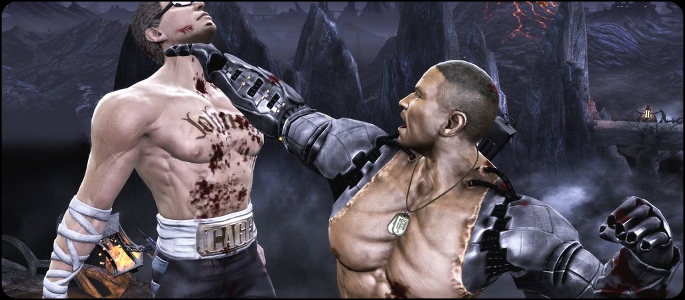
As you progress through any of the single-player events, you’ll earn koins (there’s that K again) to use in the Krypt (and again) to unlock even more goodies. Hidden within the hundreds of “krypts” are extra fatalities and alternate costumes along with some lesser important stuff like concept art and fatality sketches. Only the most hardcore of fans will be interested in it all, but at least it gives you a reason to keep on playing long after you’ve complete the Story mode and Challenge Tower.
Mortal Kombat even managed to make tutorials interesting. On top of one of the better standard tutorial modes I’ve seen in a fighter, there’s also a Fatality trainer mode that gives you a chance to practice those gruesome fatalities without the panic that sets in because you know you’ve only got a few seconds to pull it off.
Online is what you would expect — simply connect and fight to death — except for the game’s King of the Hill mode. King of the Hill mode brings back that arcade atmosphere that many never even got a chance to experience. Rather than just playing versus someone online, you’re doing so on a “stage’ where spectators can watch, heckle, cheer you on, even boo you. If you win, you stay on as the King of the Hill. Lose and you’ll get pushed to the back of the line and have to wait until every one else has had a run at the King. At that point it’s your opportunity to heckle as well. You can even assign a score from a 1-10 scale and reward the winner “respect points” if you feel their performance was up to snuff. You can learn tricks and combo chains just by watching experienced players, or if you’re experienced yourself, you’ll be watching the other’s strategies so you can counter and come out the victor. I can’t tell you enough how much I love King of the Hill mode.
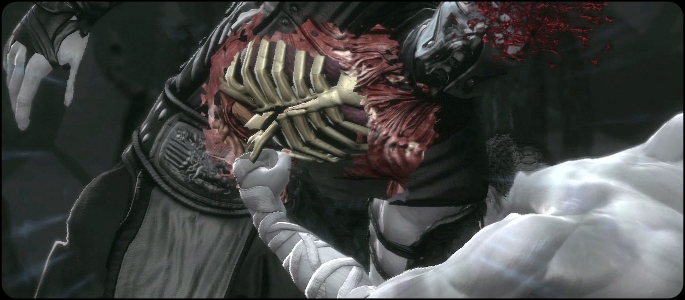
The kombat itself is more akin to classic Mortal Kombat games, namely Mortal Kombat II. There isn’t a run button or massive push-button chain combos, but you can chain shorter more effective combos and juggles with special moves to do some serious damage. Staple MK standard moves are back — things like uppercuts, sweeps and throws — and will make up the bulk of your attacks. There’s also a “super” meter that builds up as you take damage or as your opponent blocks your aggressive onslaught. The meter allows for “enhanced” special moves which increase power, speed, damage and just look so much cooler. Fill the bar to the second notch and you can now break combos if you’re taking a beating. Finally, fill the meter and unleash a bone-crushing X-ray move, appropriately named due to the X-ray close-up of the internal trauma the player is inflicting on the other’s bones and organs. X-ray moves are so brutal, they call for cringing and wincing in pain as you watch. The only problem here is the fact that they’re so powerful, they can be overused, and thus, a little played out after a while. The kombat feels fresh while feeling completely familiar. Although, it tends to be a little slow and may be a turn off for people who prefer the fast-paced gameplay from Street Fighter IV or Marvel Vs. Capcom 3.
The game looks and sounds great. Graphics are crisp (must resist the usage of K…) and everything, from the characters to the cut scenes, to the massive, detailed environment are simply stunning. Voice acting is fittingly cheesy and the sounds of pain and anguish is prevalent through every second of gameplay. Mortal Kombat also makes some of the best usage of 3D I’ve witnessed thus far in video games. It’s not overly dramatic, and the 3D is restricted to the backgrounds and some of the elements that pop; blood spurts, or a deflected Kung Lao hat throw do have that pop effect. This keeps the fighters in 2D which allows anyone watching the action without expensive glasses still completely able to enjoy it, without having to sit and watch a blurry mess. The 3D is subtle, but that may be the key to being effective.
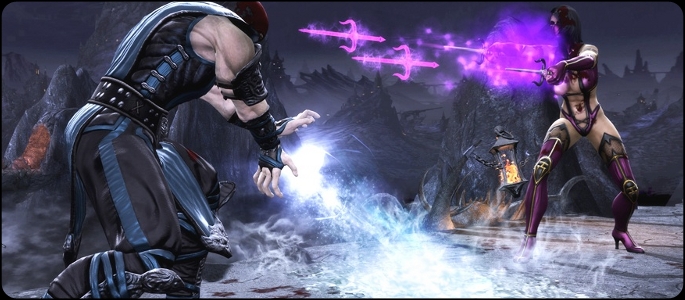
Mortal Kombat is back in full gory glory. This installment serves as the ultimate throwback for die-hard fans like myself, while still being accessible and interesting enough to lure new gamers. Unlike most fighters, there are hours and hours of single-player, plenty of replay value, and some unique twists to online multiplayer to help make it stand out among the rest. Series staple secrets are buried within the game and DLC characters are planned to help to hold your attention for a very long time. There’s really so much game here, and all of it is (said in my best Shao Kahn voice) …excellent. It’s not quite a flawless victory, but it’s the best Mortal Kombat ever, and that’s really saying a lot.
PlayStation LifeStyle’s Final Score
+ The fatalities are brutal, bloody and awesome + Tons of gameplay modes, options and secrets to keep you coming back |
 |
–

